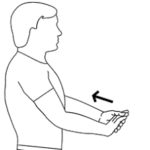As more of us work from home, we are at a higher risk of developing overuse injuries including carpal tunnel syndrome. This is a common condition that is associated with pain, numbness, and tingling in the wrist and hand. This occurs when the median nerve, one of the major nerves that travels through the forearm and hand, becomes compressed as it travels through the carpal tunnel in the wrist. Common causes of this compression and irritation to the nerve include repetitive hand and finger use when typing and writing as well as poor wrist and hand positioning while performing these activities. Here are some suggestions to help prevent and treat this condition:
- Take breaks – If you find yourself doing a lot of typing throughout the day, make sure that you are taking a 10 minute break from typing every hour at the minimum.
- Keep your wrists neutral – Avoid excessive bending of the wrists in either direction to avoid increased compression on the nerve. As you type, try to keep your wrists in a neutral or slightly extended position
- Focus on posture – The positioning of the rest of your body, including your head, neck, and shoulders can contribute to symptoms all the way into the hands. As you sit at your desk, make sure that you maintain good posture by keeping your head upright, shoulders back, and avoiding a slouched posture.
- Stretch – Tightness in the muscles of the wrist and forearm can contribute to your symptoms. As you are taking a break every hour, stretch the muscles by pulling your hand and fingers back towards you and holding for 30 seconds at a time, as seen in the picture below.

